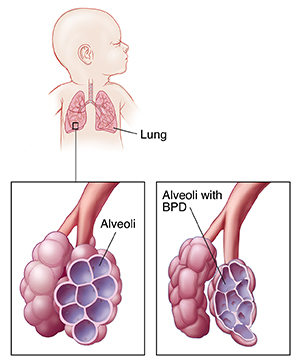Understanding Bronchopulmonary Dysplasia (BPD)
BPD is a long-term lung disease. It causes breathing problems in newborns and babies. It commonly affects babies who are born early. This means born before 32 weeks. It also affects babies of low birth weight. This means babies less than 5.5 pounds. Most babies recover from BPD. Some have breathing problems that last a long time. BPD is also called neonatal chronic lung disease (CLD).
Babies born early (preterm) can get BPD. This is because they don't have a lot of tiny air sacs (alveoli) in the lungs. After birth, the tiny air sacs are not fully developed. They don't work as they should. This may cause a lung problem called respiratory distress syndrome (RDS). These babies are kept in the neonatal intensive care unit (NICU).
Your baby may have BPD if they have breathing problems that last past a certain point. Your baby may need oxygen or a machine to help them breathe. Signs and symptoms of BPD include:

Diagnosing BPD
BPD can be mild, moderate, or severe. This is based on the amount of extra oxygen a baby needs when they reach the expected due date. Diagnosis is also based on how long your baby needs oxygen.
Your baby may have tests such as chest X-rays, blood tests, and an echocardiography. These can help healthcare providers know for sure if a baby has BPD. Babies in the NICU usually get tested daily.
Treating BPD
If your baby is born early, they may get a shot of medicine called surfactant. It coats the inside of the lungs. It helps keep your baby's lungs open after birth. It helps your baby breathe air in and out of their lungs.
Most babies who get BPD start to get better in months. Your baby will need treatments. These are to make sure your baby is getting enough oxygen. These may include:
-
A machine to help your baby breathe
-
Extra oxygen through a special hood, nasal tubes, or a face mask
-
Giving fluids through needles or tubes in your baby's veins for nutrition and growth
-
Incubators to keep your baby warm and help prevent infections
-
Ongoing monitoring of your baby's heart rate, breathing, temperature, blood pressure, and blood oxygen level
Other treatments for BPD can include:
-
Breastmilk or formula with extra nutrition added. This can be a helpful treatment. Babies with BPD often use more energy than other babies.
-
Giving your baby less fluid or giving medicines called diuretics. These can help by lowering the amount of fluid in your baby’s lungs.
-
Keeping your baby away from air pollution. This includes cigarette smoke, dust, and other things that can irritate the lungs. Ask your child's healthcare provider what else to avoid to help your baby's health.
-
Good handwashing. This is to help prevent infections. Wash your hands often with soap and water. Use hand sanitizer when you can’t wash your hands. Try to avoid family and friends who are ill.
-
Nirsevimab medicine. This is a shot to help prevent RSV. RSV is a common virus that can harm the lungs of babies with BPD. One dose of nirsevimab is recommended for infants aged 8 months and younger born during or entering their first RSV season if :
-
The mother did not receive RSV vaccine during pregnancy
-
The mother’s RSV vaccination status is unknown
-
Or, the infant was born less than 14 days after the pregnant mother's RSV vaccination
-
Palivizumab medicine. This is a treatment to help prevent RSV. RSV is a common virus that can harm the lungs of babies with BPD. The medicine is often given every 30 days during the winter months.
-
Vaccines. For a baby over the age of 6 months, flu and COVID-19 vaccines may also advised. Other vaccines may also be recommended.
Possible complications of BPD
Babies with BPD often spend weeks or even months in the NICU. After the hospital stay, babies with BPD can have other problems. These may include:
-
High blood pressure in the lungs (pulmonary hypertension)
-
Problems with the eyes (seeing, vision) and ears (hearing)
-
Delayed speech
-
Heart problems
-
Problems with normal development or learning
-
Increased risk of lung infections
-
Feeding problems, such as stomach contents back up into the throat and esophagus
Contact your baby's healthcare provider if they have new or worse symptoms.
Lowering your baby's risk
The healthcare provider may take steps to help keep a baby from getting RDS, which can lead to BPD. These steps may include: